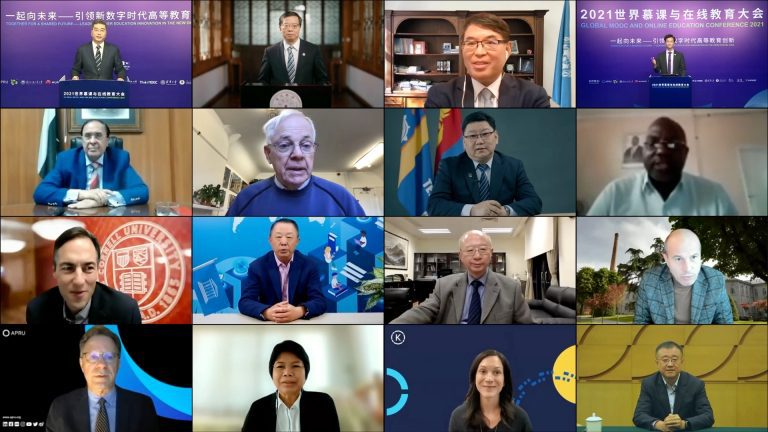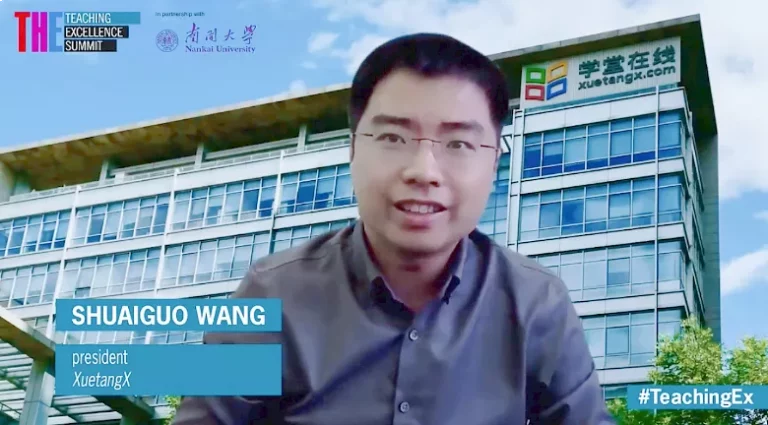Below is the keynote presentation transcript for The Honorable Mr. Wu Yan (Vice Minister, Ministry of Education, China) at the main meeting of the Global MOOC and Online Education Conference (GMC) 2023, which was held in Milan, Italy, on December 15, 2023.
Distinguished guests, ladies and gentlemen:

It is a great pleasure for me to attend the Global MOOC and Online Education Conference 2023 in the beautiful city of Milan, Italy at the invitation from the Secretariat of the Global MOOC and Online Education Alliance. Since its establishment in 2020, the Global MOOC and Online Education Alliance has successfully organized four sessions of the Global MOOC and Online Education Conference, bringing together government officials, renowned university administrators, education experts and elites from around the world to discuss the development of MOOCs and online education. The conference has witnessed the release of important outcomes such as the Beijing Declaration on MOOC Development and the Infinite Possibilities – Report on the Digital Development of Global Higher Education. It has become a significant platform and renowned brand for global exchange and collaboration in digital education.

On behalf of the Ministry of Education of the People’s Republic of China, I would like to offer my heartfelt congratulations on the successful convening of the conference, and enthusiastically welcome all the distinguished guests and representatives who are here with us at this conference. I would also like to express sincere gratitude to UNESCO, universities, institutions, and individuals from around the world who have always cared about and supported the development of education in China. I would also like to express special thanks to the organizers, the Global MOOC and Online Education Alliance, and the UNESCO Institute for Information Technologies in Education, as well as the host institutions, Politecnico di Milano and Tsinghua University, for their efforts and contributions to the success of this conference.

Throughout the history of educational development, we can see the close relationship between technology and education. Each technological revolution and industrial transformation has brought about a leap-forward development in education. Since the 21st century, a new round of technological revolution and industrial transformation has presented unprecedented opportunities for global development. The tremendous potential of digital technology has been fully unleashed, especially with the emergence of generative artificial intelligence like ChatGPT. It has provided us with significant opportunities to innovate, reshape, and promote development while also bringing new challenges. “What is the essence of education, and where should education be heading?” – this has become a common question for countries around the world to contemplate.
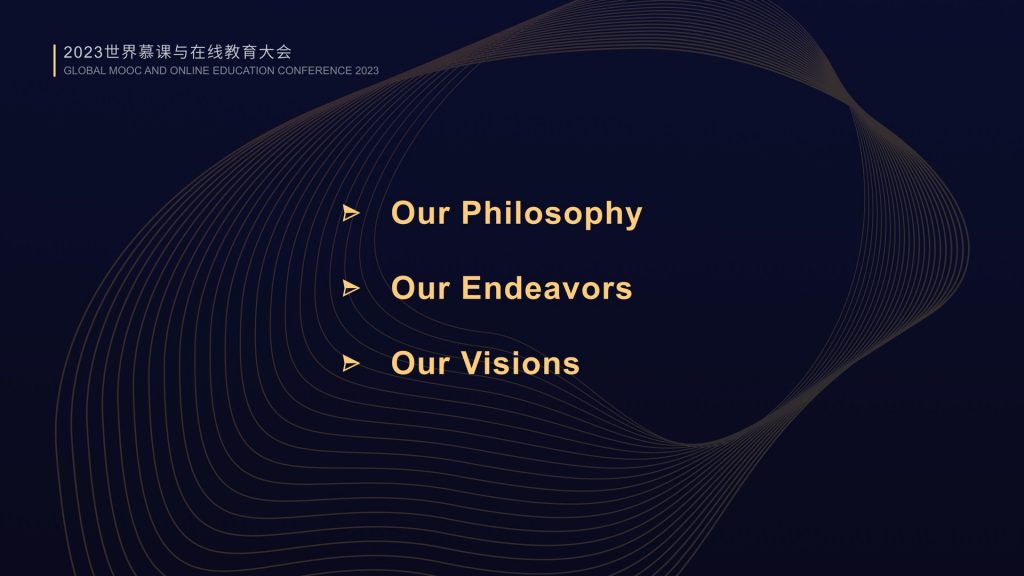
I. Our Philosophy

Distinguished guests, ladies and gentlemen,
China attaches great importance to the digital transformation of higher education. President Xi Jinping has pointed out that ” digital education is where our country can achieve breakthroughs in opening up new areas and forming fresh strength of educational development.” We deeply understand that the digital transformation of higher education is not just a strategic issue but a strategic choice and innovative path that influences and even determines the quality development of higher education, enabling a revolution in learning, quality, and overall development.
We believe that the digital transformation of education is a gradual process.

In order to assess and predict the overall trends in global higher education, we have systematically analyzed the current state of global digital development and proposed that the development of the digital transformation of education can be divided into three stages. The first stage is the transformation stage, where infrastructure gradually improves, software and hardware are refined, and digital technologies are integrated into higher education. The second stage is the transition stage, where higher education undergoes self-transformation and enhancement. Universities achieve modern governance through digital technologies, providing learners with comprehensive, smart, and personal services to meet diverse learning needs. The third stage is the intelligence stage, where the boundaries between higher education and society are further broken, resulting in holistic changes in educational concepts, teaching models, and educational governance. This empowers learners for comprehensive development and creates a new ecosystem for education.
We believe that the digital transformation of education should uphold the “3Cs”.

The digital transformation of education has three characteristics: Connection: the essence of the Internet is connection. To promote the digital transformation of education, we need to connect as much as possible, enabling more users to be online, platforms to be interconnected, and data to be shared. Through connection, we can leverage the multiplier and spillover effects of the Internet. Content: we need to optimize the quality of educational resources using digital technologies, enhance content attractiveness and influence, and thereby increase user engagement and loyalty. Cooperation: we need to fully harness the power of various stakeholders, create synergy to promote the vigorous digital development of education, and build a diverse and participatory ecosystem for the digital transformation of education.
We believe that the digital transformation of education should adhere to “four principles.”

Adhere to application supremacy: Emphasize the importance of methods over technology and organizational innovation over technological innovation; Digital development should be driven by the needs of applications. Adhere to the service-oriented approach: Focus on solving the pain points, difficulties, and bottlenecks in teaching and learning, ensuring that teachers and students have a better experience. Adhere to simplicity and efficiency: Establish standards and norms, integrate existing resources, and connect scattered “pearls” from different fields into a “necklace.” Adhere to security: Network security and IT application are two sides of the same coin, requiring coordinated development and security measures to protect the bottom line of network security.
We believe that the digital transformation of education should achieve comprehensive integration.

By accelerating digital transformation, promoting the comprehensive integration of information technology and education, and driving collaborative progress at both the “material” and “human” levels, technology must ultimately serve the needs of education. We need to follow the inherent patterns of digital development, focus on student-centered approaches, provide more personal and diverse education products and services, establish smarter education processes, implement more diverse education evaluations, foster a more connected and open education culture, build a sustainable higher education system, and create a fairer, high-quality, and better future for higher education.
II. Our Endeavors

Distinguished guests, ladies and gentlemen,
Currently, China has 3,013 higher education institutions with a total enrollment of 46.55 million students. The gross enrollment rate in higher education is approaching 60%, entering a globally recognized stage of popularization. In the new track of the digital transformation of education, Chinese higher education plays a leading role, realizing the transition from limited to abundant high-quality resources, from small to large-scale learning, and from shallow to deep application levels. It has achieved significant results in improving educational quality, promoting a learning revolution, and responding to challenges posed by the COVID-19 pandemic. China has explored a path of the digital transformation of education with Chinese characteristics!
(I) Building a more efficient and connected learning environment

China is accelerating the improvement of digital hardware and software conditions that cover all stages of basic education, vocational education, and higher education, including pre-class preparation, classroom teaching, and post-service, to support the world’s largest education system.
- We have established high-speed networks. In recent years, China has built educational and scientific research computer networks, and established a 30,000-kilometer fiber-optic transmission network with a total bandwidth of 3Tb, covering 1,873 universities and research institutions.
- We have gathered powerful computing capabilities. In TOP 500’s 2022 list of supercomputers worldwide, more than 50 supercomputer systems are deployed in universities, with 17 of them located in Chinese higher education institutions. Additionally, China has established partnerships with first-rate companies such as Alibaba and Tencent to establish computing alliances.
- We have built digital campuses. We have issued standards for digital campus development, guiding universities to create future learning environments represented by smart classrooms, virtual training rooms, and future learning centers.
- We have created national platforms. In 2022, the “Smart Education of China” public service platform was launched and received the 2022 UNESCO King Hamad Bin Isa Al-Khalifa Prize for the Use of Information and Communication Technologies (ICT) in Education. UNESCO recognized that the platform is comprehensive, providing a wealth of learning resources aligned with the curriculum, including 44,000 basic education items covering various grades and subjects, 19,000 vocational education items, and 27,000 online courses for higher education. It also provides training for millions of teachers, promoting the quality and equity of education in China.
(II) Building more abundant and diverse educational resources

The rapid development of Massive Open Online Courses (MOOCs) is a vivid reflection of China’s thriving digital transformation of education. The year 2012 marked the beginning of MOOCs worldwide, and in 2013, China established its first MOOC platform. Over the past decade, we have been promoting the development of MOOCs and online education with universities as the mainstay, the government as a supporter, and involving the whole society. We have held the China MOOC Conference, and the Global MOOC Conference, and initiated the establishment of the Global MOOC and Online Education Alliance. As of now, the number of MOOCs launched in China has exceeded 76,800, with a registered user base of 454 million and a total of 1.277 billion learning instances. MOOC credits have been recognized for 415 million students currently enrolled in educational institutions.
(III) Creating more ubiquitous and smart application scenarios

We have galvanized engaged teachers to utilize online education resources such as MOOCs to carry out reforms in teaching methods, including online teaching, flipped classrooms, and hybrid learning, continuously promoting the comprehensive integration of information technology and education.
- We have effectively responded to the unprecedented COVID-19 pandemic. During the outbreak of the COVID-19 pandemic, we engaged thousands of schools, millions of teachers, and tens of millions of students to utilize high-quality MOOC resources, igniting a learning revolution across the country’s universities. This not only effectively addressed the impact of the pandemic but also led to a series of changes in teaching concepts, technologies, standards, methods, and evaluations.
- We have launched the “MOOCs to the West” initiative. Through hybrid teaching methods based on MOOCs, including online and offline learning and synchronous classrooms, we have offered 198,400 MOOCs and customized courses to universities in educationally disadvantaged western China regions. This initiative has facilitated 5.0694 million instances of hybrid learning, with 536 million student enrollments.
- We have enabled internships and training with digital technology. By simulating real-life scenarios through digital technology, we have developed over 6,000 virtual simulation laboratory courses, helping universities overcome challenges related to high-risk or extreme environments, high costs, and high resource consumption, where traditional experiments were difficult or impossible to conduct effectively.
- We have supported entrepreneurship and employment services. The “Smart Education of China · Higher Education” platform connects 193,000 employers and aggregates 17.55 million job postings. Additionally, a “Maker-MOOCs Platform” section has been established, selecting nearly 500 quality resources, including innovative and entrepreneurial MOOCs, micro-courses, virtual simulation laboratory experiences, and 100 innovation and entrepreneurship practice education bases.
(IV) Promoting more open and inclusive communication and collaboration

China has been actively promoting the openness and sharing of digital educational resources, fostering communication and collaboration among teachers, universities, platforms, and globally, to provide more diverse and higher-quality resources for learners worldwide.
- We have established international platforms for open sharing. During the COVID-19 pandemic, China developed two online international teaching platforms, “iCourses” and “XuetangX,” which have offered over 1,000 international courses in more than 14 languages. These platforms cover 177 countries and regions, becoming public course platforms recommended by UNESCO to the world.
- We have actively advanced “MOOCs Going Global.” China’s MOOC platform XuetangX signed a cooperation agreement with the national platform of Indonesia, providing 300 quality MOOCs from 88 Chinese universities to facilitate online learning for students from over 3,000 Indonesian universities.
- We have explored the establishment of hybrid classrooms. Universities such as Tsinghua University in China collaborated with Politecnico di Milano in Italy, Nanyang Technological University in Singapore, and Universidad de Chile in Chile to offer 341 global hybrid classroom programs through a combination of online and offline approaches, achieving credit recognition among 13 prestigious universities in 11 countries.
(V) Pursuing more in-depth and comprehensive theoretical research

Last year, the Secretariat of the Global MOOC and Online Education Alliance compiled the Infinite Possibilities – Report on the Digital Development of Global Higher Education and the Digital Development Index of Global Higher Education, which received enthusiastic responses from the international community. Soon, the conference will witness the release of the Report on the Digital Development of Global Higher Education 2023 and the Digital Development Index of Global Higher Education 2023. This year’s report focuses on the application scenarios of digital technology in higher education, dividing the evolution of educational digital technology over the past century into five stages. It predicts six key technological pillars that will impact the future development of higher education and proposes six action strategies for global collaboration in response to digital transformation. Meanwhile, the Digital Development Index of Global Higher Education examines 105 practical cases from 31 countries, regions, international organizations, and over 70 global universities and institutions from four dimensions: digital education, digital school-running, digital management, and digital support. These theoretical achievements will provide valuable references for countries to understand and grasp the global level of the digital transformation of higher education. The Chinese government highly appreciates these efforts.
III. Our Visions
Distinguished guests, ladies and gentlemen,
Digital technology has penetrated all areas of education. However, while digital technology brings opportunities to higher education, it also faces many challenges. Traditional educational models, the digital divide, cybersecurity threats, ethical risks, and disparities in digital literacy all require urgent attention and in-depth discussion to find solutions. Therefore, we believe that in order to achieve breakthroughs we need to fully leverage digital technology to promote new transformations.
First, transform student learning.

In the digital age, there are higher requirements for students’ digital literacy. It is imperative to use digital technology to change students’ learning and build a learning ecosystem that adapts to the digital era. We need to promote more equitable learning, connecting regions through network cables and facilitating access to quality resources. We need to promote more personal learning by applying digital technology to transform student development models in higher education and achieve tailored instruction for the digital era. We need to promote more convenient learning by creating independent learning spaces using libraries, study rooms, and other facilities, and develop new scenarios where everyone can learn anytime and anywhere.
Second, transform teacher instruction.

In the digital age, teachers’ work efficiency will be greatly enhanced, and classroom presentations will become more diverse. We need to support teachers in reducing workload and increasing effectiveness by popularizing smart teaching tools, empowering teachers with digital technology, and relieving their preparation and tutoring pressures. We need to support the creation of digital classrooms. In terms of hardware, we will advance the building of “digital campuses” and “smart campuses”, creating future classrooms. In terms of software, we will improve the quality of digital educational resources, providing teachers with quality digital resources. We need to support the development of the teaching workforce by establishing and promoting remote virtual teaching research rooms, supporting collaborative teaching practices among teachers from different universities and regions, and enhancing teachers’ digital literacy.
Third, transform educational governance.

In the digital age, educational management and decision-making will shift from linear processes to data-centric, flat, and platform-oriented approaches, transitioning from “broad-based” management to “targeted” governance. We need to promote efficient management by using big data to monitor campus environments and teacher-student dynamics in a timely manner, implementing targeted management, and improving management efficiency. We need to promote convenient services by deepening service reforms for teachers and students, optimizing service processes, and enhancing the service experience through digital technology. We need to promote data-driven decision-making by building a big data analysis and decision-making system, aggregating and analyzing data in real-time, and mining its value to enhance the intelligence of educational governance.
Fourth, transform the educational ecosystem.

In the digital age, traditional higher education is facing challenges on all fronts, and digital technology will inevitably drive profound transformations in education. In this context, we need to transform the organizational forms of education by integrating online and offline approaches, promoting interdisciplinary exchanges, and blending internal and external resources to create future schools that integrate the virtual and the real. We need to explore open and flexible credit recognition and degree-granting mechanisms. We need to transform educational and instructional models by advancing the “classroom revolution”, conducting data-driven learning diagnosis and targeted interventions, and constructing a new educational model based on “teacher-machine-student” integration to promote the integration of large-scale education and personal development. We need to transform the evaluation mechanisms in education by comprehensively utilizing new technologies such as artificial intelligence and big data to achieve multidimensional, process-oriented, and scientific evaluations of students’ comprehensive qualities.
Distinguished guests, ladies and gentlemen,
Technology empowers education, and education shapes the future. Currently, China is vigorously advancing the building of a digital China and implementing national strategies for the digital transformation of education. Early next year, China will host the 2nd World Digital Education Conference in Shanghai. Hereby, we sincerely invite all the distinguished guests to attend the conference and engage in exchanges and discussions on the digital transformation of education. We hope to join hands with countries around the world, understand and adapt to the new requirements of the digital transformation era, achieve breakthroughs in opening up new areas, form fresh Strength of educational development, and contribute to the creation of a more vibrant, inclusive, and high-quality future higher education through the digital transformation of education.
Thank you!
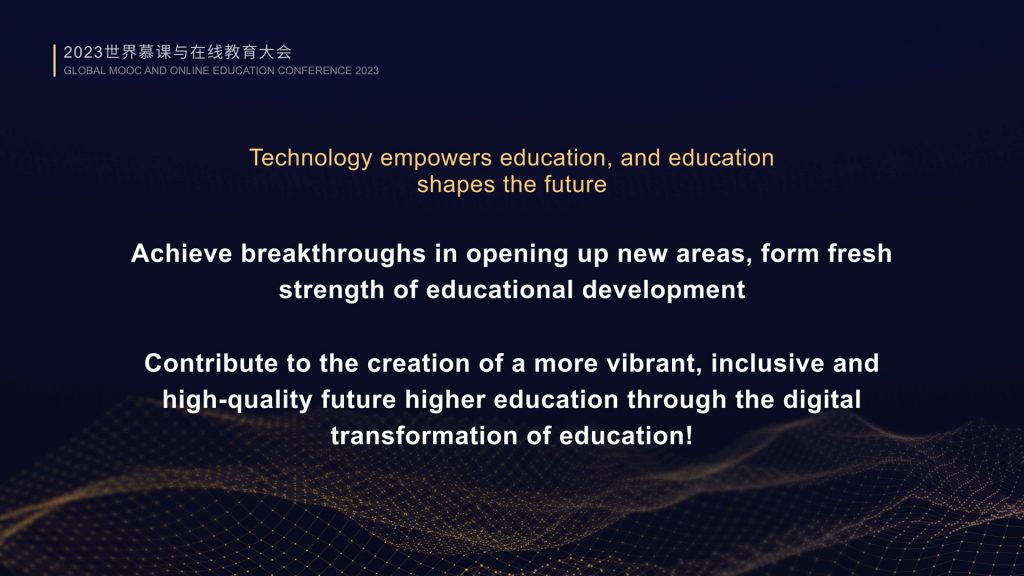

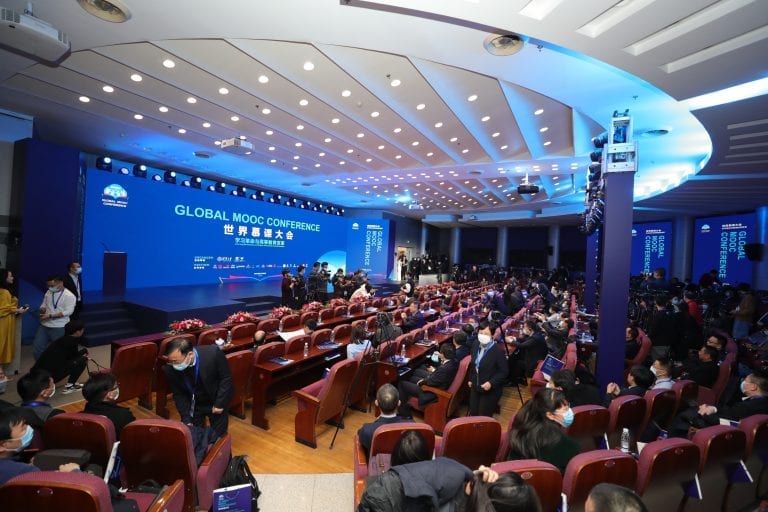
![[OED Host Reflect] XU Luping: “Can AI, operating based on patterns and established structures, cultivate innovation and creativity?”](https://n6m6d6c3.rocketcdn.me/wp-content/uploads/2023/06/IMG_9144-768x576.jpg)
